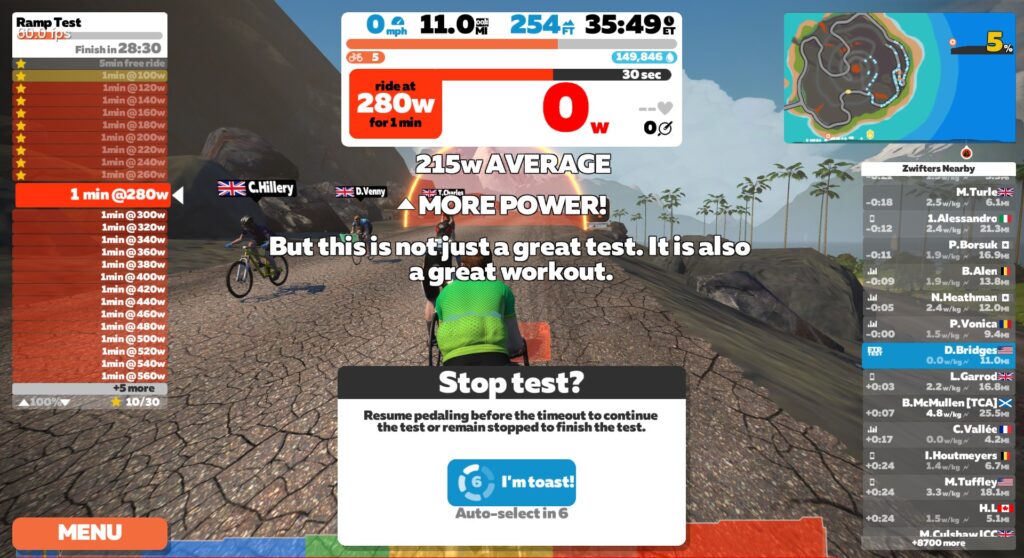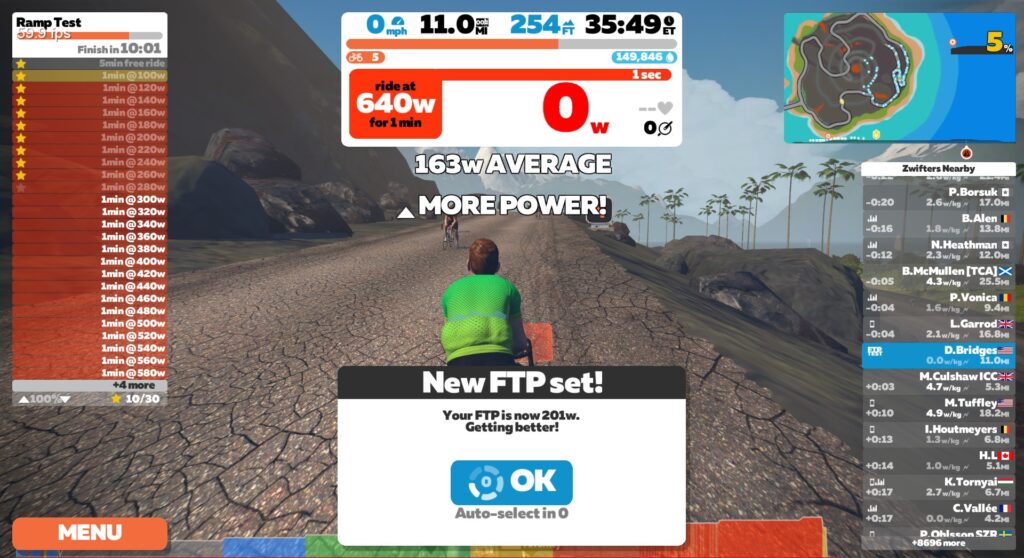If you’re new to cycling training, you’ve probably never taken an FTP test. Heck, you probably have no idea what an FTP test even is! Let’s cover the basics of FTP, and options for testing it on Zwift.
What is FTP?
FTP is short for Functional Threshold Power. It’s the most commonly-used metric of fitness for cyclists, and measures the maximum power you can hold for longer durations. Going above your FTP will result in blood lactate levels increasing until you “blow up”, but if you’re fresh and well-fueled you should be able to ride at FTP for anywhere from 40-60 minutes.
While FTP is often described as the max power you can average for 60 minutes, that is not how it was actually defined by those who pioneered its use. Andrew Coggan defined it as, “The highest power that a rider can sustain in a quasi-steady state without fatiguing.”
Why Test Your FTP?
On Zwift, knowing your FTP is important for two reasons:
- Your FTP setting determines the power requirements for intervals in structured workouts. If your FTP is set too low you won’t get an adequate workout, and if it’s set too high you won’t be able to hit your power targets.
- Most Zwift races are categorized by FTP in watts per kilogram (your FTP divided by your weight in kg – a 300W FTP for a 75kg rider would be a 4 w/kg FTP). If you don’t know your FTP, you may jump into a category of riders well under or over your fitness level. (Good news – Zwift’s new category enforcement features, once rolled out across the platform, should prevent riders from joining too low of a category.)
How To Test Your FTP on Zwift
Here’s the simple 4-step process used by most Zwifters:
- Kit up, boot up
- Pick a test from the workout options under Training>FTP Tests
- Follow the instructions on screen, destroying yourself in the process
- If your FTP increases, share it on Zwift Riders. If it does not, never mention this test to anyone. 🙂
Let’s take a closer look at the FTP test options Zwift provides.
4 FTP Test Options on Zwift
FTP Test

The original “standard” FTP test, this one is also the longest, at 73 minutes. It includes 3 short ramps, plus a 5-minute interval over FTP which is meant to take the snap out of your legs so your 20-minute test uses less anaerobic power and more aerobic power.
In this workout, the 20-minute test is all that matters. Your FTP result will be computed as 95% of the power you average during the 20-minute free ride interval.
FTP Test (Shorter)

A shortened version of the original test, this one only lasts 45 minutes but still includes the key components. Just one ramp effort, and a slightly harder 5-minute block, but you’re still going to do an all-out 20-minute effort. The warmup and cooldown periods are significantly shortened.
Ramp Test

The ramp test starts easy, then simply increases your wattage by 20W every minute until you can’t pedal anymore. It’s a much shorter test than the two FTP tests above, and you don’t have to worry about pacing yourself for a 20-minute effort. Just stay seated and pedal for all you’re worth, until you can’t pedal anymore! Typically the ramp test feels very easy at the start, but gets really hard in the last 5 minutes.



Zwift will calculate your FTP once you stop pedaling. Your FTP Is calculated as 75% of the highest 1-minute power averaged during the test. If your new FTP is higher than your old one you’ll get a popup that says a “New FTP set!”
Ramp Test Lite

If you weigh less than 60kg/132lbs, you’ll want to take the “Ramp Test Lite” instead of the standard ramp test, because this test starts at a lower wattage and increases by only 10W per minute. It’s a ramp test made for lighter riders with a lower FTP.
Which FTP Test is Best?
Everything about the ramp test is easier than the standard FTP test, but the downside is ramp tests can be less accurate, depending on your physiology. Specifically, riders with a higher anaerobic to aerobic power balance may have their FTP overstated by a ramp test.
On the other hand, the standard FTP test and its 20-minute all-out effort is very challenging, both mentally and physically. Additionally, newer riders will struggle to properly pace a 20-minute effort (they often blow up early).
Both styles of tests have their pros and cons, but generally speaking if you are a beginning cyclist and/or you want a quicker, easier test, go with a ramp format. If you want higher accuracy, and have the experience to pace yourself properly, go with the 20-minute format.
If you’ve never taken an FTP test, we recommend using the ramp test first. This will give you a fairly accurate FTP number, which you can use to pace yourself for the 20-minute test next time.
Automatic FTP Detection

Many Zwifters get FTP Increase notes in Zwift without ever taking an FTP test. How? Because Zwift is always measuring your best 20-minute power as you ride, and if 95% of your best 20 minute wattage exceeds your current FTP setting in game, Zwift will alert you to a new FTP.
Example: your FTP is set to 200W in game. You do a short Crit City race, and your best 20-minute power during that race was 220W. Zwift will alert you to a new FTP of 209W (220 * .95) and update your saved FTP value when you save your ride.
While this method of FTP detection doesn’t quite match the standard testing protocol, it’s a simple proxy for an actual test.
Most cycling data platforms will compute an estimated FTP based on your ride data, even if you never take an FTP test. These calculated FTP figures are arguably more accurate than an FTP test, but it depends on how they’re calculated and what sort of efforts you’re feeding into their algorithms. Some of these platforms are free, while others may carry fees. Popular platforms include intervals.icu (free, plugs into your Strava data), Xert, and WK05 software.
Questions or Comments?
Share below!
